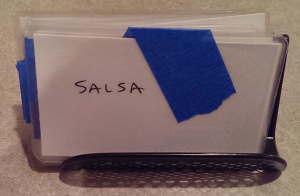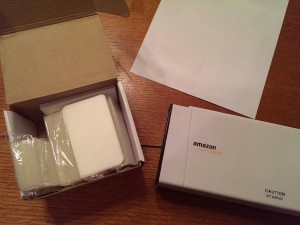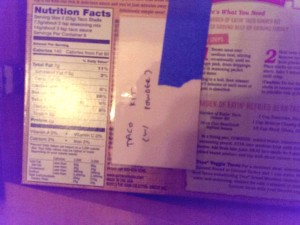Kanban for groceries

“I can’t believe it took him this long to do this.”
-my wife, in reference to the kanban-for-groceries system I set up while she was on a business trip. I’m not entirely sure what this quote means. 🙂
The term “kanban” in Japanese essentially means “card.” “Kanban” is used widely in Lean manufacturing to refer to signalling systems based around cards. (“Kanban” is also the name for a newish type of agile software development process. I am not talking about that process here.) To learn more about kanban as used in Lean, I implemented a Lean-style kanban system for our home groceries.
This all started when my wife went on a long business trip. I had enough time to try out a kanban system on my own and see whether it worked. 🙂
The idea behind kanban is that you need a way to signal upstream processes (e.g. the “buy groceries” process) when you need inventory, and that a simple visual system is more accurate than a computer system while also highlighting opportunities for process improvement.
For example, if I were in shipping and needed another part made so that I could ship it, I would send a kanban card upstream representing that part. As the part was manufactured, the card would come back with the part.
Kanban cards can also be the basis for fancier process improvements, for example to help you attain “every part, every day” (EPED).
I have never worked in a manufacturing environment and wanted to try out a kanban system, so I’ve set up a kanban process at our house for groceries.
Tellingly (?), I found no information online about how to set up a kanban system for your home groceries. I think I found a simple approach. I believe this is very much in line with Lean principles: keep it very simple.
Below is how the process works so far, and how you could go about trying this yourself (for home or work).
Goal
The goal of this kanban-for-groceries process is to ensure we always have staple groceries while making it easy to ensure we know exactly what needs to be bought from the grocery store.
Materials used

- AmazonBasics thermal laminator (~$25)
- Blank business cards (~$10)
- 5mil business card laminating pouches x500 (~$10)
- Pen
- Painter’s tape
- Business card holder (~$2.50)
Process overview

A card exists for every grocery that we ought to have in our house. For example, if we ought to have three loaves of bread then there are three cards labeled “Bread” each attached to a loaf of bread.
The cards are attached to the groceries. When we use up the grocery, it goes into a stack. That stack represents all the groceries we need to replace.
For fruit and other stuff that you can’t easily tape, the cards are nearby.
We probably have 100 cards right now.
Making the cards
When we realize we need another staple, we create a card for it. I have been batching the lamination until right before we go to the store, since it takes the laminator five minutes to heat up.
Using groceries
When we use a grocery, we take the card off the grocery and add it to the stack of “to-purchase” cards.
Buying groceries
When we’re going to buy groceries, we take all the cards in the stack and sort them by where they are in the grocery store. As we go through the store and find the groceries, the card goes into the “bought this” pile. If we don’t find something, I put it into the “didn’t find this” pile.
We also buy stuff that we don’t have cards for–this is stuff for meals we’ll cook that week, but that isn’t a staple for us.
When we get home, I have been doing the tedious step of attaching cards to groceries. If the card doesn’t have painter’s tape, or the tape isn’t good, I replace the tape.
Affixing the cards to the just-bought groceries is the most painful part of this process. I don’t think I can get away with taping the cards in the grocery store (although I have definitely thought about it). Affixing the cards probably takes 10 minutes.
The “didn’t find this” pile (all the groceries we didn’t find) goes straight into the “to-purchase” stack when we get home.
Outcomes and lessons learned
Affixing the cards: painter’s tape works well. I tried glue dots and post-it glue, but neither worked well.
Lamination is required. The cards are on groceries in the freezer and the refrigerator. They can also get wet easily. The whole point is that you keep the cards around, and laminations help them endure weeks of grocery trips.
I have a much, much higher degree of confidence that we’re always going to have staples but never too much of a staple. Before, we might forget what we had in the house and end up having extra groceries. Now, I believe we’re always going to have exactly enough of staples such as bread, mustard, peanut butter, and lentil soup.
If we went to the grocery store twice a week, it would be extremely easy to “top up” our groceries only getting what we need from each trip.
I didn’t realize this, but the system has also helped our son learn to read and share in the chores. He wants to know what’s on the cards and likes to participate in buying groceries by being given cards for each grocery we need.